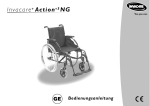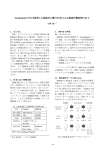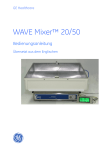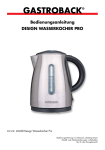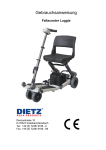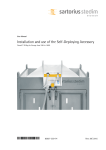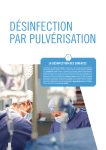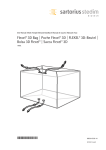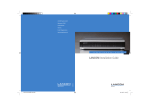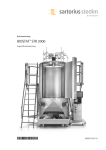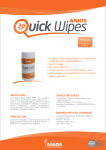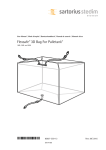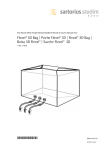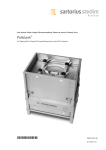Download Plastic Palletank® for Storage 200 L and 500 L
Transcript
User Manual | Mode d’emploi | Benutzerhandbuch | Manual de usuario | Manuale d’uso Plastic Palletank® for Storage 200 L and 500 L Plastic Palletank® pour le stockage 200 L et 500 L | Kunststoff-Palletank® zur Aufbewahrung 200 L und 500 L | Palletank® de plástico para el almacenamiento 200 L y 500 L | Plastic Palletank® per lo stoccaggio 200 L e 500 L 85032-538-69 85032-538-69 IU113102-Rev03 Table of Contents English page 2 Français page 11 Deutsch Seite 20 Español página 29 Italiano pagina 38 Sartorius Stedim Biotech Flexsafe® | Flexel® 3D Bag is for SINGLE-USE ONLY. Sartorius Stedim Biotech will not be held responsible in case of re-use of the Flexsafe® | Flexel® 3D Bag 1. Introduction 2 2.Plastic Palletank® for Storage – Folding, unfolding, dismantling and moving instructions 3.Cleaning and maintenance instructions 3 4. Precautions of use 9 5. Specifications 9 6. Disclaimers 9 7. Warranty 10 8. Trademark 10 8 1. Introduction Thank you for choosing the Flexsafe® | Flexel® 3D System from Sartorius Stedim Biotech for your manufacturing requirements. The Flexsafe® | Flexel® 3D System is composed of a single-use sterile bag, the Flexsafe® | Flexel® 3D Bag and the Palletank® rigid container made of plastic. The Plastic Palletank® For Storage supports the fluid contained within the Flexsafe® | Flexel® 3D Bag and as such the two make up the System and must be used together. The Flexsafe® | Flexel® 3D Bags are manufactured according to a patented design that precisely fit the Palletank®. Typical applications for the Flexsafe® | Flexel® 3D System include in-process formulation, storage, handling and transfer of biopharmaceutical fluids under sterile conditions. The Plastic Palletank® for storage represents a cost-effective containment solution for the storage and processing of biopharmaceutical fluids contained in Flexsafe® | Flexel® 3D Bags. Their flat, smooth surfaces and rounded corners ensure the highest level of hygiene, ease of cleaning and safe operations. The collapsible Plastic Palletank® for storage require minimal storage space when not in use and their efficient stacking allows for optimal floor space utilization when filled. They are available in standard sizes of 200 L and 500 L to fit with 100 L | 200 L and 500 L Flexsafe® | Flexel® 3D Bags. Purpose: The user manual describes the operations required to fold, unfold and dismantle the Plastic Palletank® for Storage. 2 2. Plastic Palletank® for Storage – Folding, unfolding, dismantling and moving instructions Notice: It is recommended to have 2 operators to fold, unfold and dismantle the 500 L size. 2.1. Unfolding a) Starting from the folded Palletank®, remove the lid (See Figure 1). Figure 1 b) Unfold first the front and back panels (See Figure 2). They stay in place by design. Figure 2 3 c) Position the side panels by lifting them up in-between the front and back panels. (See Figure 3) The side panels overlap the front and back panels and lock by design into position. (See Figure 3.1 and 3.2) Figure 3 Figure 3.1 Figure 3.2 d) Insert the Flexsafe® | Flexel® 3D Bag in the Palletank® and fill it according to the “Flexsafe® | Flexel® 3D Bag Instructions for Use” provided with each box of Flexsafe® | Flexel® 3D Bags. (See Figure 4) Figure 4 2.2. Folding When not in use, the collapsible Palletank® can be folded to approximate half of its height for intermediate storage. In order to fold the Plastic Palletank® for Storage, perform the a) to c) operations in reverse sequence. 4 2.3. Dismantling The four panels of the Plastic Palletank® For Storage can be dismantled to simplify cleaning operations. The Palletank® has to be folded prior to dismantling. a) Remove the first panel > 200 L size Pull the panel horizontally toward you to unlock it as shown on Figure 5. Figure 5 > 500 L size Remove the four black latches of the first panel by pushing it as shown on Figure 6. Maintain the latches for later use. b) Perform the same operations to remove the three other panels. Figure 6 5 2.4. Mounting > 200 L size a) Position horizontally one of the smaller panel in its dedicated area and lock it into position (See Figure 7). The small panel must be positioned in such a way that the volume indicators are inside the bin. Figure 7 b) Perform the same operations with the secondary small panel, followed by the two large panels. > 500 L size a) Position vertically one of the smaller panel in its dedicated area (See Figure 8). The small panel must be positioned in such a way that the volume indicators are inside the bin. Figure 8 b) Secure the side panel by positioning the four black latches (See Figure 9). Latch for the large panels c) Perform the same operations with the secondary small panel, followed by the two large panels Latch for the small panels Figure 9 6 2.5. Moving around of the Palletank® The Plastic Palletank® for storage can be either moved around the facility using its dedicated dolly or using a forklift. > Using a dolly The Plastic Palletank® for storage can be moved around using its dedicated dolly (See igure 10). The table below provides with the dedicated dolly reference and specifications F according to the Palletank® volume. Figure 10 Description STD Palletank® Accessory Dolly Volume 200L 500L Part Number FXA116630 FXA116631 Construction Material 304 L and polyamide (wheels) Surface Finishing Glass bead blasted Dimensions (w + d + h) 807 + 607 + 214 mm 32 + 24 + 8 in. 1207 + 807 + 214 mm 47 + 32 + 8 in. Weight (approx.) 10 kg (22 lb) 20 kg (44 lb) > Using a forklift The Plastic Palletank® for storage can be moved around using a forklift. Precautions must be taken in terms of where to insert the forklift at the bottom of the alletank®. The figures 11 and 12 show the right positioning of the forklift at the bottom of P the Palletank® versus the wrong positioning for both the 200 L and the 500 L. This recommendation applies for both front, back and side apertures. Not following this precaution of use may lead to Palletank® damages. Figure 11 Figure 12 7 3. Cleaning and maintenance instructions 3.1. Introduction The container does not come into contact with the fluid. However periodic cleaning | disinfections cycles are recommended at a frequency dependent upon the nature of use (type of application and environment into which the Palletank® is taken). In order to simplify the cleaning | disinfection cycles, the four panels of the Plastic Palletank® for Storage can be dismantled. The bottom pallet can also be dismantled by unscrewing the 4 screws. 3.2. Cleaning and disinfection Concerning the chemical resistance of Plastic Palletank® For Storage, the compatibility of PP and ABS has been checked with cleaning and decontaminating agents commonly used in the biopharmaceutical industry as summarized in the table below: PP ABS ANIOS DETERG’ANIOS SURFANIOS SURFANIOS IP SURFANIOS PAE IP BACTERANIOS SF BACTERIANOS SF IP BACTERANIOS SF PAE IP ANIOSPRAY SF ANIOSPRAY SF IP ANIOSPRAY WS IP yes yes yes yes yes yes yes yes yes yes yes yes yes yes yes yes yes yes yes yes STERIS CIP100 SPORKLENZ RTU yes yes yes yes VETOQUINOL VIRKON yes yes The compatibility with the main materials of construction was checked according to manufacturer standard operating procedure. In case of any doubt or operating procedures different from those advised by the manufacturer, we urged you to consult directly your cleaning agent supplier for detailed advises. 8 4. Precautions of use 5. Specifications The Palletank® must be clean and dry before inserting the Flexsafe® | Flexel® 3D Bag. Traces of cleaning agents left on the Palletank® can potentially damage the Flexsafe® | Flexel® 3D Bag. Description STD Plastic Palletank® Storage STD Plastic Palletank® Storage 200 L 500 L Part number FXC116215 FXC116216 Bag Volume(s) 100 L | 200 L 500 L1 Main Construction Material PP Precautions must be followed when using a forklift to move around the Plastic Palletank® for storage. Carefully follow instructions given in section 2.5. Dimensions (w + d + h) – Approx: – Unfolded ABS 805 + 607 + 969 mm (32 + 24 + 38 in.) 1215 + 805 + 1086 mm (48 + 31 + 43 in.) – Folded 805 + 607 + 510 mm (32 + 24 + 20 in.) 1215 + 805 + 572 mm (48 + 31 + 22 in.) Weight incl. lid (approx.) 25 kg (55 lb) 79 kg (174 lb) Bottom gate 1 1 Stackability-Static – Folded 5 3 – Unfolded 3 2 6. Disclaimers a) Sartorius Stedim Biotech Flexsafe® | Flexel® 3D Bag is for SINGLE-USE only. Sartorius Stedim Biotech will not endorse any responsibility for re-use of the Flexsafe® | Flexel® 3D Bag. b) Sartorius Stedim Biotech will not be held responsible if the “Plastic Palletank® for storage Instructions for Use” as described in this document is not strictly followed and the above mentioned Precautions of Use applied. Upon request, Sartorius Stedim Biotech engineers can perform training of employees. c) Sartorius Stedim Biotech is not responsible for any special, incidental or consequential damages resulting from any legal theory, including lost profits, downtime, goodwill, damage to or replacement of equipment or property. 1 The maximum filling volume of the Flexel® 3D Bag in the 500 L Plastic Palletank® for storage is 490 L. 9 7. Warranty Sartorius Stedim Biotech warrants that the Flexsafe® | Flexel® 3D Bag and Plastic Palletank® for storage are produced according to Sartorius Stedim Biotech specifications. Unless otherwise specified, the general Sartorius Stedim Biotech specifications will apply. 8.Trademark Flexsafe® | Flexel® and Palletank® are registered trademarks of Sartorius Stedim Biotech. 10 Table des matières La poche Sartorius Stedim Biotech Flexsafe® | Flexel® 3D est SEULEMENT destinée à un USAGE UNIQUE. Sartorius Stedim Biotech décline toute responsabilité en cas de réutilisation de la poche Flexsafe® | Flexel® 3D. 1. Introduction 11 2.Plastic Palletank® pour le stockage – 12 Instructions de pliage, de dépliage, de démontage et de déplacement 3.Instructions de nettoyage et 17 de maintenance 4. Précautions d’utilisation 18 5. Caractéristiques techniques 18 6. Clauses de non-responsabilité 18 7. Garantie 19 8. Marque commerciale 19 1. Introduction Merci d’avoir choisi le système Flexsafe® | Flexel® 3D de Sartorius Stedim Biotech pour vos opérations de production. Le système Flexsafe® | Flexel® 3D se compose d’une poche stérile à usage unique, la poche Flexsafe® | Flexel® 3D, et d’un conteneur rigide Palletank® en plastique. Le Plastic Palletank® pour le stockage maintient la poche Flexsafe® | Flexel® 3D contenant le fluide. Les deux dispositifs sont donc indispensables pour constituer un système et doivent être utilisés ensemble. Les poches Flexsafe® | Flexel® 3D sont fabriquées selon une schéma breveté parfaitement adapté au Palletank®. Les applications classiques du système Flexsafe® | Flexel® 3D sont la formulation au cours du processus, le stockage, la manipulation et le transfert de fluides biopharmaceutiques dans des conditions stériles. Le Plastic Palletank® pour le stockage constitue une solution économique pour le stockage et le traitement de fluides biopharmaceutiques dans des poches Flexsafe® | Flexel® 3D. Ses surfaces planes et lisses ainsi que ses angles arrondis assurent un degré d’hygiène maximal, un nettoyage facile et une utilisation sûre. Les Plastic Palletank® pour le stockage sont pliables et ne prennent donc que très peu de place quand ils sont vides. Quand ils sont remplis, il est également possible de les empiller pour une utilisation optimale de l’espace au sol. Ils sont disponibles dans des tailles standard de 200 L et 500 L adaptées aux poches Flexsafe® | Flexel® 3D de 100 L | 200 L et 500 L. Objectif : Ce mode d’emploi décrit les opérations nécessaires pour plier, déplier et démonter le Plastic Palletank® pour le stockage. 11 2. Plastic Palletank® pour le stockage – Instructions de pliage, de dépliage, de démontage et de déplacement Remarque : Il est recommandé d’être à deux pour plier, déplier et démonter les Plastic Palletank® de 500 L. 2.1. Dépliage a) Enlever le couvercle du Palletank® plié (voir figure 1). Figure 1 b) Déplier d’abord les panneaux avant et arrière (voir figure 2). Ils restent en place de par leur conception. Figure 2 12 c) Positionner les panneaux latéraux en les relevant entre les panneaux avant et arrière (voir figure 3). Les panneaux latéraux chevauchent les panneaux avant et arrière et se bloquent en position verticale de par leur conception (voir figures 3.1 et 3.2). Figure 3 Figure 3.1 Figure 3.2 d) Mettre en place la poche Flexsafe® | Flexel® 3D dans le Palletank® et la remplir en suivant les instructions du « Mode d’emploi de la poche Flexsafe® | Flexel® 3D » fourni avec chaque carton de poches Flexsafe® | Flexel® 3D (voir figure 4). Figure 4 2.2. Pliage Quand il n’est pas utilisé, le Palletank® pliable peut être replié d’environ la moitié de sa hauteur pour un stockage provisoire. Pour plier le Plastic Palletank® pour le stockage, effectuer les opérations a) à c) dans l’ordre inverse. 13 2.3. Démontage Les quatre panneaux du Plastic Palletank® pour le stockage peuvent être démontés pour simplifier les opérations de nettoyage. Le Palletank® doit être plié avant d’être démonté. a) Enlever le premier panneau > Taille 200 L : Tirer le panneau vers vous, à l’horizontale, pour le déverrouiller. Voir la figure 5. Figure 5 > Taille 500 L : Enlever les quatre loquets noirs du premier panneau en le poussant comme indiqué sur la figure 6. Conserver les loquets pour une utilisation ultérieure. b) Procéder de la même manière pour enlever les trois autres panneaux. Figure 6 14 2.4. Montage > Taille 200 L : a) Positionner le premier panneau latéral à l’horizontale dans l’emplacement prévu à cet effet et le verrouiller (Voir Figure 7). Le petit panneau doit être monté de manière à ce que les indicateurs de volume soient à l’intérieur du conteneur. Figure 7 b) Procéder de la même manière avec le deuxième petit panneau, puis avec les deux grands panneaux. > Taille 500 L : a) Mettre un des petits panneaux verticalement à l’endroit prévu (voir figure 8). Pour le 500 L, le petit panneau doit être monté de manière à ce que les indicateurs de volume soient à l’intérieur du conteneur. Figure 8 Loquet pour les grands panneaux b) Fixer le panneau latéral à l’aide des quatre loquets noirs (voir figure 9). c) Procéder de la même manière avec le deuxième petit panneau, puis avec les deux grands panneaux. Loquet pour les petits panneaux Figure 9 15 2.5. Déplacement du Palletank® Le Plastic Palletank® pour le stockage peut être soit déplacé en utilisant son chariot à roulettes dédié soit en utilisant un chariot élévateur. > Utilisation du chariot à roulettes dédié Le Plastic Palletank® pour le stockage peut être déplacé en utilisant son chariot à roulettes dédié. Le tableau ci-dessous donne les références du chariot à roulettes ainsi que ses spécifications en fonction du volume du Palletank®. Figure 10 Description Chariot pour Palletank® STD Volume 200 L 500 L Référence FXA116630 FXA116631 Principale matière de construction 304 L et polyamide (roulette) Finition de surface Microbillé Dimensions (L + P + H) 807 + 607 + 214 mm 32 + 24 + 8 in. 1207 + 807 + 214 mm 47 + 32 + 8 in. Poids (approx.) 10 kg (22 lb) 20 kg (44 lb) > En utilisant un chariot élévateur Le Plastic Palletank® pour le stockage peut être déplacé en utilisant un chariot élévateur. Des précautions doivent être prises quant à l’insertion du chariot élévateur sous le Palletank®. Les figures 11 et 12 montrent le bon positionnement du chariot élévateur versus le mauvais positionnement pour les Plastic Palletank® de volumes 200 L et 500 L. Cette recommandation doit s’appliquer à la fois pour l’insertion du chariot élévateur à l’avant, à l’arrière ou sur les côtés du Palletank®. Le non-respect de cette précaution d’utilisation peut provoquer l’endommagement du Palletank®. Figure 11 Figure 12 16 3. Instructions de nettoyage et de maintenance 3.1. Introduction Le conteneur n’est pas en contact avec le liquide. Toutefois, il est recommandé d’effectuer périodiquement des cycles de nettoyage | désinfection dont la fréquence dépend de la nature de l’utilisation (type d’application et environnement dans lequel le Palletank® est utilisé). Pour simplifier les cycles de nettoyage | désinfection, il est possible de démonter les quatre panneaux du Plastic Palletank® pour le stockage. La palette du bas peut également être démonté en dévissant les 4 vis. 3.2. Nettoyage et désinfection En ce qui concerne la résistance chimique du Plastic Palletank® pour le stockage, la compa tibilité du PP et de l’ABS a été vérifiée avec des produits nettoyants et décontaminants habituellement utilisés dans l’industrie biopharmaceutique et dont la liste se trouve dans le tableau ci-dessous : PP ABS ANIOS DETERG’ANIOS SURFANIOS SURFANIOS IP SURFANIOS PAE IP BACTERANIOS SF BACTERIANOS SF IP BACTERANIOS SF PAE IP ANIOSPRAY SF ANIOSPRAY SF IP ANIOSPRAY WS IP oui oui oui oui oui oui oui oui oui oui oui oui oui oui oui oui oui oui oui oui STERIS CIP100 SPORKLENZ RTU oui oui oui oui VETOQUINOL VIRKON oui oui La compatibilité avec les principales matières de construction a été vérifiée conformément au mode opératoire normalisé du fabricant. En cas de doute ou de modes opératoires différents de ceux indiqués par le fabricant, nous vous conseillons vivement de vous adresser directe ment à votre fournisseur de produits nettoyants pour obtenir des conseils précis. 17 4. Précautions d’utilisation 5. Caractéristiques techniques Assurez-vous que le Palletank® est propre et sec avant de mettre en place la poche Flexsafe® | Flexel® 3D. Des traces de produit nettoyant sur le Palletank® peuvent endommager la poche Flexsafe® | Flexel® 3D. Description STD Plastic Palletank® pour le stockage 200 L STD Plastic Palletank® pour le stockage 500 L Référence FXC116215 FXC116216 Volume(s) de la poche 100 L | 200 L 500 L1 Principale matière de construction PP ABS 805 + 607 + 969 mm (32 + 24 + 38 in.) 1215 + 805 + 1 086 mm (48 + 31 + 43 in.) – Plié 805 + 607 + 510 mm (32 + 24 + 20 in.) 1215 + 805 + 572 mm (48 + 31 + 22 in.) Poids avec couvercle (env.) 25 kg (55 lb) 79 kg (174 lb) Ouverture dans le fond 1 1 Possibilité d’empilage stable – Plié 5 3 – Déplié 3 2 Des précautions doivent être prises quant au déplacement du Plastic Palletank® avec un chariot élévateur. Suivre strictement les instructions données dans le paragraphe 2.5. Dimensions (L + P + H) – env. : – Déplié 6. Clauses de non-responsabilité a) La poche Sartorius Stedim Biotech Flexsafe® | Flexel® 3D est uniquement destinée à un USAGE UNIQUE. Sartorius Stedim Biotech décline toute responsabilité en cas de réutilisation de la poche Flexsafe® | Flexel® 3D. b) Sartorius Stedim Biotech ne pourra pas être tenu pour responsable en cas de non-observation des « Instructions d’utilisation du Plastic Palletank® pour le stockage » décrites dans ce document et des précautions d’utilisation mentionnées plus haut. Sur demande, les techniciens de Sartorius Stedim Biotech peuvent se charger de la formation des employés. c) Sartorius Stedim Biotech n’est pas responsable des dommages spéciaux, accessoires ou indirects issus d’une théorie juridique, y compris ceux causant une perte de profit, une immobilisation ou affectant la notoriété, ainsi que des dommages ou le remplacement de l’équipement ou de biens matériels. 1 18 L e volume maximum de remplissage d’une poche Flexel® 3D dans un Plastic Palletank® 500 L pour le stockage est de 490 L. 7. Garantie Sartorius Stedim Biotech garantit que la poche Flexsafe® | Flexel® 3D et le Plastic Palletank® pour le stockage sont fabriqués conformément aux spécifications de Sartorius Stedim Biotech. Sauf dispositions contraires, les spécifications générales de Sartorius Stedim Biotech seront appliquées. 8.Marque commerciale Flexsafe® | Flexel® et Palletank® sont des marques déposées de Sartorius Stedim Biotech. 19 Inhalt Der Sartorius Stedim Biotech Flexsafe® | Flexel® 3D-Beutel ist NUR ZUM EINMALIGEN GEBRAUCH vorgesehen. Sartorius Stedim Biotech haftet nicht bei der Wiederverwendung eines Flexsafe® | Flexel® 3D-Beutels. 1. Einleitung 20 2.Kunststoff-Palletank® zur 21 Aufbewahrung – Anweisungen zum Zusammen- und Auseinanderklappen, zur Zerlegung sowie zum Transport 3.Reinigungs- und Wartungsanleitung 26 4.Vorsichtsmaßnahmen bei der Verwendung 27 5. Technische Daten 27 6. Haftungsausschlüsse 27 7. Gewährleistung 28 8. Marke 28 1. Einleitung Danke, dass Sie sich für Ihre Fertigungsanforderungen für das Flexsafe® | Flexel® 3D-System von Sartorius Stedim Biotech entschieden haben. Das Flexsafe® | Flexel® 3D-System besteht aus einem sterilen Einweg-Beutel, dem Flexsafe® | Flexel® 3D-Beutel, sowie einem starren Kunststoffbehälter, dem Palletank®. Der Kunststoff-Palletank® zur Aufbewahrung unterstützt den mit Flüssigkeit gefüllten Flexsafe® | Flexel® 3D-Beutel. Die beiden Komponenten bilden ein System und müssen zusammen verwendet werden. Die Flexsafe® | Flexel® 3D-Beutel sind nach einem patentierten Design hergestellt, das genau in den Palletank® passt. Typische Anwendungsbereiche für das Flexsafe® | Flexel® 3D-System sind u. a. prozessinterne Rezeptherstellungen sowie Lagerung, Handling und Transfer von biopharmazeutischen Flüssigkeiten unter sterilen Bedingungen. Der Kunststoff-Palletank® zur Aufbewahrung ist eine kostengünstige Aufbewahrungslösung zur Lagerung und Verarbeitung von biopharmazeutischen Flüssigkeiten in Flexsafe® | Flexel® 3D-Beuteln. Seine flachen, glatten Oberflächen und abgerundeten Kanten gewährleisten ein Höchstmaß an Hygiene, ein leichtes Reinigen und einen sicheren Betrieb. Der zusammenklappbare Kunststoff-Palletank® zur Aufbewahrung benötigt im leeren Zustand nur minimalen Platz und durch die effiziente Stapelmöglichkeit im befüllten Zustand wird die Stellfläche optimal ausgenutzt. Er ist in den Standardgrößen 200 Liter und 500 Liter erhältlich und für die Flexsafe® | Flexel® 3D-Beutel mit einem Fassungsvermögen von 100 l | 200 l und 500 l geeignet. Verwendungszweck: Das Benutzerhandbuch beschreibt die Maßnahmen, die zum Zusammen- und Auseinander klappen sowie zur Zerlegung des Kunststoff-Palletank® zur Aufbewahrung erforderlich sind. 20 2. Kunststoff-Palletank® zur Aufbewahrung – Anweisungen zum Zusammen- und Auseinanderklappen, zur Zerlegung sowie zum Transport Hinweis: Es wird empfohlen, dass die Größe 500 l von 2 Bedienern zusammen- und auseinandergeklappt bzw. zerlegt werden. 2.1. Auseinanderklappen a) Entfernen Sie bei dem zusammengeklappten Palletank® zunächst den Deckel (siehe Abbildung 1). Abbildung 1 b) Klappen Sie dann zunächst das vordere und das hintere Paneel aus (siehe Abbildung 2). Sie sind so konzipiert, dass sie nicht wieder einklappen. Abbildung 2 21 c) Positionieren Sie die Seitenpaneele, indem Sie sie zwischen dem vorderen und dem hinteren Paneel hochziehen (siehe Abbildung 3). Die Seitenpaneele überlappen das vordere und das hintere Paneel und sind so konzipiert, dass sie in der dafür vorgesehenen Position einrasten (siehe Abbildungen 3.1 und 3.2). Abbildung 3.1 Abbildung 3.2 Abbildung 3 d) Legen Sie den Flexsafe® | Flexel® 3D-Beutel in den Palletank® und befüllen Sie ihn gemäß der „Gebrauchsanweisung zum Flexsafe® | Flexel® 3D-Beutel“, die im Lieferumfang jeder Packung Flexsafe® | Flexel® 3D-Beutel enthalten ist (siehe Abbildung 4). Abbildung 4 2.2. Zusammenklappen Wenn der zusammenklappbare Palletank® nicht verwendet wird, kann er zur Zwischen lagerung auf ungefähr die Hälfte der Höhe zusammengeklappt werden. Um den KunststoffPalletank® zur Aufbewahrung zusammenzufalten, führen Sie die Schritte a) bis c) in umgekehrter Reihenfolge durch. 22 2.3. Zerlegung Die vier Paneele des Kunststoff-Palletank® zur Aufbewahrung lassen sich abnehmen, um so die Reinigung zu vereinfachen. Der Palletank® muss vor dem Zerlegen zusammengeklappt werden. a) Nehmen Sie erste Paneel ab Größe > 200 l Ziehen Sie das Paneel in horizontaler Richtung zu sich hin (siehe Abbildung 5). Abbildung 5 Größe > 500 l Zum Entnehmen drücken Sie bitte die vier schwarzen Verriegelungen des ersten Paneels nach unten (siehe Abbildung 6). Verwahren Sie die Verriegelungen für die spätere Wiederverwendung. b) Zum Abnehmen der übrigen drei Paneele wiederholen Sie die oben genannten Schritte. Abbildung 6 23 2.4. Montage Größe > 200 l a) Legen Sie eines der kleineren Paneele horizontal auf das hierfür vorgesehene Feld, und verriegeln Sie es (siehe Abbildung 7). Das kleine Paneel muss so angeordnet sein, dass die Volumenanzeigen sich im Behälter inneren befinden. Abbildung 7 b) Wiederholen Sie dieselben Schritte für das zweite kleine Paneel und anschließend für die beiden großen. Größe > 500 l a) Legen Sie eines der kleineren Paneele vertikal auf das hierfür vorgesehene Feld. Das kleine Paneel muss so angeordnet sein, dass die Volumenanzeigen sich im Behälterinneren befinden. Abbildung 8 Verriegelung für die großen Paneele b) Sichern Sie das Seitenpaneel durch Anbringen der vier schwarzen Verriegelungen (siehe Abbildung 9). c) Wiederholen Sie dieselben Schritte für das zweite kleine Paneel und anschließend für die beiden großen Paneele. Verriegelung für die kleinen Paneele Abbildung 9 24 2.5. Transport des Palletank® Der Kunststoff-Palletank® zur Aufbewahrung kann in der Einrichtung entweder auf dem speziellen Transportwagen oder mit einem Gabelstapler transportiert werden. > Auf dem Transportwagen Der Kunststoff-Palletank® zur Aufbewahrung kann auf dem speziellen Transportwagen t ransportiert werden (siehe Abbildung 10). Die folgende Tabelle enthält die technischen Daten des speziellen Transportwagens je nach Größe des Palletank®. Abbildung 10 Beschreibung Optionaler Transportwagen für STD-Palletank® Volumen 200 l 500 l Artikelnummer FXA116630 FXA116631 Herstellungsmaterial 304 L und Polyamid (Räder) Oberfläche Glasperlengestrahlt Maße (B + T + H) 807 + 607 + 214 mm (32 + 24 + 8 Zoll) 1207 + 807 + 214 mm (47 + 32 + 8 Zoll) Gewicht (ca.) 10 kg (22 lb) 20 kg (44 lb) > Mit einem Gabelstapler Der Kunststoff-Palletank® zur Aufbewahrung kann mit einem Gabelstapler transportiert werden. Gehen Sie vorsichtig vor, wenn Sie die Gabeln des Gabelstaplers auf der Unterseite des Palletank® einschieben. Die Abbildungen 11 und 12 zeigen jeweils die korrekte und falsche Position des Gabelstaplers auf der Unterseite des Palletank® für die Größen 200 l und 500 l. Diese Empfehlung gilt für die vorderen, hinteren und seitlichen Öffnungen. Eine Nichtbeachtung dieser Vorsichtsmaßnahmen kann zur Beschädigung des Palletank® führen. Abbildung 11 Abbildung 12 25 3. Reinigungs- und Wartungsanleitung 3.1. Einleitung Der Behälter kommt nicht mit der Flüssigkeit in Berührung. Es werden jedoch regelmäßige Reinigungs- | Desinfektionszyklen empfohlen, wobei die Häufigkeit von der Verwendungsart abhängig ist (Art der Anwendung und Umgebung, in die der Palletank® gelangt). Zur Vereinfachung der Reinigungs- | Desinfektionszyklen lassen sich die vier Paneele des Kunststoff-Palletank® zur Aufbewahrung abnehmen. Auch die Bodenpalette lässt sich durch das Herausdrehen der 4 Schrauben abbauen. 3.2. Reinigung und Desinfektion Was die Beständigkeit des Kunststoff-Palletank® zur Aufbewahrung anbelangt, so wurde die Kompatibilität von PP und ABS mit in der biopharmazeutischen Industrie gängigen Reinigungs- und Dekontaminationsmitteln geprüft, wie in der nachstehenden Tabelle zusammengefasst: PP ABS ANIOS DETERG’ANIOS SURFANIOS SURFANIOS IP SURFANIOS PAE IP BACTERANIOS SF BACTERIANOS SF IP BACTERANIOS SF PAE IP ANIOSPRAY SF ANIOSPRAY SF IP ANIOSPRAY WS IP Ja Ja Ja Ja Ja Ja Ja Ja Ja Ja Ja Ja Ja Ja Ja Ja Ja Ja Ja Ja STERIS CIP100 SPORKLENZ RTU Ja Ja Ja Ja VETOQUINOL VIRKON Ja Ja Die Kompatibilität mit den Hauptkonstruktionsmaterialien wurde gemäß dem StandardBetriebsablauf des Herstellers überprüft. Wenn Sie Zweifel haben oder wenn Ihre Betriebs abläufe von denen des Herstellers abweichen, empfehlen wir nachdrücklich, sich für eine detaillierte Beratung direkt an Ihren Reinigungsmittellieferanten zu wenden. 26 4. Vorsichtsmaßnahmen bei der Verwendung 5. Technische Daten Der Palletank® muss sauber und trocken sein, bevor ein Flexsafe® | Flexel® 3D-Beutel eingesetzt wird. Spuren von Reinigungs mitteln, die im Palletank® verbleiben, können den Flexsafe® | Flexel® 3D-Beutel beschädigen. Beschreibung STD-Kunststoff-Palletank® zur Aufbewahrung 200 l STD-Kunststoff-Palletank® zur Aufbewahrung 500 l Artikelnummer FXC116215 FXC116216 Beutelvolumen 100 l | 200 l 500 l1 Hauptsächlich verwendetes Herstellungsmaterial PP ABS 805 + 607 + 969 mm (32 + 24 + 38 Zoll) 1215 + 805 + 1086 mm (48 + 31 + 43 Zoll) 805 + 607 + 510 mm (32 + 24 + 20 Zoll) 1215 + 805 + 572 mm (48 + 31 + 22 Zoll) Gehen Sie vorsichtig vor, wenn Sie den Kunststoff-Palletank® zur Aufbewahrung mit dem Gabelstapler transportieren. Beachten Sie unbedingt die Anweisungen in Abschnitt 2.5. Maße (B + T + H) – Ca.: – Auseinandergefaltet – Zusammengefaltet Gewicht einschließlich Deckel (ca.) 25 kg (55 lb) 79 kg (174 lb) Bodenablass 1 1 Stapelbarkeit - Statisch – Zusammengefaltet 5 3 – Auseinandergefaltet 3 2 6. Haftungsausschlüsse a) Der Sartorius Stedim Biotech Flexsafe® | Flexel® 3D-Beutel ist nur zum EINMALIGEN GEBRAUCH vorgesehen. Sartorius Stedim Biotech haftet nicht bei Wiederverwendung eines Flexsafe® | Flexel® 3D-Beutels. b) Sartorius Stedim Biotech übernimmt keine Haftung, wenn die Gebrauchsanweisung für den „Kunststoff-Palletank® zur Aufbewahrung“, wie in diesem Dokument beschrieben, nicht strengstens befolgt und die oben aufgeführten Vorsichtshinweise nicht beachtet werden. Auf Anfrage können die Techniker von Sartorius Stedim Biotech Mitarbeiterschulungen durchführen. c) Sartorius Stedim Biotech ist nicht haftbar für spezielle, beiläufig entstandene Schäden oder Folgeschäden auf der Basis einer wie auch immer gearteten rechtlichen Grundlage, einschließlich Verlusten, Ausfallzeiten, Goodwill, Schäden an oder Austausch von Geräten oder Eigentum. 1 Das maximale Füllvolumen des Flexel® 3D-Beutels innerhalb des 500 L Kunststoff-Palletanks® zur Aufbewahrung beträgt 490 L. 27 7. Gewährleistung Sartorius Stedim Biotech gewährleistet, dass der Flexsafe® | Flexel® 3D-Beutel und der Kunststoff-Palletank® zur Aufbewahrung gemäß den Spezifikationen von Sartorius Stedim Biotech hergestellt werden. Sofern nicht anderweitig angegeben, gelten die allgemeinen Spezifikationen von Sartorius Stedim Biotech. 8.Marke Flexsafe® | Flexel® und Palletank® sind eingetragene Marken von Sartorius Stedim Biotech. 28 Contenido La bolsa Flexsafe® | Flexel® 3D de Sartorius Stedim Biotech es DE UN SOLO USO. Sartorius Stedim Biotech no será responsable de ninguna consecuencia que pueda derivarse de reutilizar una bolsa Flexsafe® | Flexel® 3D. 1. Introducción 29 2.Palletank® de plástico para el almacenamiento – instrucciones para el plegado, desplegado, desmontaje y transporte 3.Instrucciones de limpieza y de mantenimiento 30 4. Precauciones de uso 36 5. Especificaciones 36 6. Exención de responsabilidades 36 7. Garantía 37 8. Marca comercial 37 35 1. Introducción Gracias por elegir el sistema Flexsafe® | Flexel® 3D de Sartorius Stedim Biotech para sus procesos de fabricación. El sistema Flexsafe® | Flexel® 3D consta de una bolsa estéril de un solo uso, de la bolsa Flexsafe® | Flexel® 3D y del contenedor rígido Palletank® de plástico. El Palletank® de plástico para almacenamiento soporta el fluido contenido en la bolsa Flexsafe® | Flexel® 3D, formando ambos componentes el sistema y debiendo utilizarse en todo momento conjuntamente. Las bolsas Flexsafe® | Flexel® 3D se fabrican con un diseño patentado que encaja con precisión en el Palletank®. Son aplicaciones típicas del sistema Flexsafe® | Flexel® 3D la formulación durante el proceso, el almacenamiento, la manipulación y la transferencia de fluidos biofarmacéuticos en condiciones estériles. El Palletank® de plástico para almacenamiento es una solución rentable para el almacena miento y procesamiento de fluidos biofarmacéuticos contenidos en bolsas Flexsafe® | Flexel® 3D. Sus superficies planas, lisas y con esquinas redondeadas garantizan el máximo nivel de higiene, facilidad de limpieza y seguridad. El Palletank® para almacenamiento es plegable, por lo que ocupa un espacio mínimo cuando no se utiliza. Pero incluso durante su uso puede apilarse eficazmente para reducir la superficie de suelo ocupada. Están disponibles en tamaños estándar de 200 y 500 litros para acoger, respectivamente, bolsas Flexsafe® | Flexel® 3D de 100 | 200 y 500 litros. Objetivo: Este manual del usuario describe los procedimientos que deben realizarse para desplegar, plegar y desmontar el Palletank® de plástico para almacenamiento. 29 2. Palletank® de plástico para el almacenamiento – instrucciones para el plegado, desplegado, desmontaje y transporte Aviso: Se recomienda que las operaciones de plegado, desplegado y desmontaje de los modelos de 500 litros sean realizadas por dos personas. 2.1. Desplegado a) Con el Palletank® plegado, retire la tapa (ver figura 1). Figura 1 b) Despliegue primero los paneles frontal y posterior (ver la figura 2). Están diseñados para permanecer en su lugar. Figura 2 30 c) Posicione los paneles laterales poniéndolos en pie entre los paneles frontal y posterior. (Ver figura 3) > Tamaños de 200 y de 500 litros: Los paneles laterales están diseñados para solaparse con los paneles frontal y posterior, quedando encajados en su posición correcta. (Ver figuras 3.1 y 3.2) Figura 3 Figura 3.1 Figura 3.2 d) Introduzca la bolsa Flexsafe® | Flexel® 3D en el Palletank® y rellénela según lo indicado en las “Instrucciones de uso de la bolsa Flexsafe® | Flexel® 3D” suministradas con cada caja de bolsas Flexsafe® | Flexel® 3D. (Ver figura 4) Figura 4 2.2. Plegado Cuando no vaya a utilizarse, el Palletank® puede plegarse a aproximadamente la mitad de su altura, para su almacenamiento a medio plazo. El Palletank® de plástico para almacenamiento se pliega realizando en orden inverso los procedimientos a) a c). 31 2.3. Desmontaje Los cuatro paneles del Palletank® de plástico para almacenamiento pueden desmontarse para simplificar los trabajos de limpieza. Antes de desmontarlo, el Palletank® debe plegarse. a) Retire el primer panel > tamaño 200 L Tire horizontalmente del panel hacia usted para desbloquearlo, según se ilustra en la Figura 5. Figura 5 > tamaños 500 L Retire los cuatro pasadores negros del primer panel presionando según se ilustra en la Figura 6. Conserve los pasadores para su uso posterior. b) Efectúe las mismas operaciones para retirar los otros tres paneles. Figura 6 32 2.4. Montaje > tamaño 200 L a) Coloque horizontalmente uno de los paneles pequeños en su lugar previsto y bloquéelo en su posición (ver Figura 7). El panel pequeño debe colocarse de manera que los indicadores de volumen queden dentro de la caja. Figura 7 b) Fije el panel lateral colocando los cuatro pasadores negros (ver Figura 9). > tamaños 500 L a) Coloque verticalmente uno de los paneles pequeños en su lugar previsto (ver Figura 8). En el 500 L, el panel pequeño debe colocarse de manera que los indicadores de volumen queden dentro de la caja. Figura 8 Pasador para los paneles grandes b) Fije el panel lateral colocando los cuatro pasadores negros (ver Figura 9). c) Realizar las mismas operaciones con el panel secundario pequeño, seguido de los dos paneles grandes. Pasador para los paneles pequeños Figura 9 33 2.5. Desplazamiento del Palletank® El Palletank® para almacenamiento de plástico puede desplazarse alrededor de la instalación utilizando su plataforma deslizante propia o con ayuda de una carretilla elevadora. > Utilización de la plataforma deslizante El Palletank® para almacenamiento de plástico puede desplazarse utilizando su plataforma deslizante propia (ver figura 10), La tabla de abajo ofrece referencias y especificaciones de la plataforma en función del volumen del Palletank®. Descripción Figura 10 STD Palletank® plataforma accesoria Volumen 200 L 500 L Número de serie FXA116630 FXA116631 Material de construcción 304 L y poliamida (ruedas) Acabado de la superficie Micropulido con chorro de perlas Dimensiones (an + fo + al) 807 + 607 + 214 mm 32 + 24 + 8 pulgadas 1207 + 807 + 214 mm 47 + 32 + 8 pulgadas Peso (aprox.) 10 kg (22 lb) 20 kg (44 lb) > Utilización de una horquilla elevadora El Palletank® para almacenamiento de plástico puede desplazarse utilizando una horquilla elevadora. Es necesario prestar atención a la hora de introducir la horquilla en la parte inferior del Palletank®. Las figuras 11 y 12 muestran tanto el punto correcto de inserción de la horquilla elevadora como el punto incorrecto en el Palletank®, para las dos versiones de 200 y 500 l. Esta recomendación es válida para ambos orificios, frontales, traseros y laterales. El incumplimiento de esta recomendación puede provocar daños en el Palletank®. Figura 11 Figura 12 34 3. Instrucciones de limpieza y de mantenimiento 3.1. Introducción El contenedor no entra en contacto con el fluido. Aún así, se recomienda realizar ciclos periódicos de limpieza | desinfección, cuya frecuencia dependerá del tipo y grado de utilización (tipo de aplicación y entorno en el que se utilice el Palletank®). Para simplificar los ciclos de limpieza | desinfección, los cuatro paneles del Palletank® de plástico para almacenamiento son desmontables. El panel inferior también puede desmontarse desenroscando los 4 tornillos. 3.2. Limpieza y desinfección Con respecto a la resistencia química del Palletank® de plástico para almacenamiento, se ha comprobado la compatibilidad de PP y ABS con los productos de limpieza y desconta minación utilizados habitualmente en la industria biofarmacéutica indicados en la tabla siguiente: PP ABS ANIOS DETERG’ANIOS SURFANIOS SURFANIOS IP SURFANIOS PAE IP BACTERANIOS SF BACTERIANOS SF IP BACTERANIOS SF PAE IP ANIOSPRAY SF ANIOSPRAY SF IP ANIOSPRAY WS IP sí sí sí sí sí sí sí sí sí sí sí sí sí sí sí sí sí sí sí sí STERIS CIP100 SPORKLENZ RTU sí sí sí sí VETOQUINOL VIRKON sí sí Se ha comprobado la compatibilidad con los principales materiales de construcción siguiendo el procedimiento operativo estándar del fabricante. En caso de duda o de procedimientos operativos distintos de los recomendados por el fabricante, consulte directamente a su proveedor de productos de limpieza para obtener información detallada. 35 4. Precauciones de uso 5. Especificaciones Antes de insertar la bolsa Flexsafe® | Flexel® 3D, el Palletank® debe estar limpio y seco. Si quedasen restos de productos de limpieza en el Palletank®, la bolsa Flexsafe® | Flexel® 3D podría resultar dañada. Descripción Palletank® de plástico para almacenamiento STD 200 l Palletank® de plástico para almacenamiento STD 500 l Número de pedido FXC116215 FXC116216 Volúmenes de las bolsas 100 l | 200 l 500 l1 Material de construcción principal PP ABS 805 + 607 + 969 mm (32 + 24 + 38 pulg.) 1215 + 805 + 1086 mm (48 + 31 + 43 pulg.) – plegado 805 + 607 + 510 mm (32 + 24 + 20 pulg.) 1215 + 805 + 572 mm (48 + 31 + 22 pulg.) Peso con tapa (aprox.) 25 kg (55 lb) 79 kg (174 lb) Acceso inferior 1 1 Apilabilidad-estática – plegado 5 3 – desplegado 3 2 A la hora de desplazar el Palletank® para el almacenamiento de plástico deben tomarse las debidas precauciones. Observe escrupulosamente la instrucciones del apartado 2.5. Dimensiones (ancho + fondo + alto) – aprox.: – desplegado 6. Exención de responsabilidades a) La bolsa Flexsafe® | Flexel® 3D de Sartorius Stedim Biotech es DE UN SOLO USO. Sartorius Stedim Biotech no asumirá responsabilidad alguna por las consecuencias que puedan derivarse de reutilizar la bolsa Flexsafe® | Flexel® 3D. b) Sartorius Stedim Biotech no será responsable de ninguna consecuencia que pueda derivarse de no cumplir estrictamente las “Instrucciones de uso del Palletank® de plástico para almacenamiento” descritas en este documento, así como las “Precauciones de uso” mencionadas anteriormente. Bajo petición, los ingenieros de Sartorius Stedim Biotech pueden formar a empleados. c) Sartorius Stedim Biotech no será responsable de ningún daño especial, incidental o consecuente que pueda derivarse de ningún concepto legal, como lucro cesante, tiempo de inactividad, pérdida del fondo de comercio, daños en equipos o propiedades, o sustitución de estos. 1 36 En el Palletank® Plástico para almacenaje de 500 L, el volumen máximo de llenado de la Bolsa Flexel® 3D es de 490 L. 7. Garantía Sartorius Stedim Biotech garantiza que la bolsa Flexsafe® | Flexel® 3D y el Palletank® de plástico para almacenamiento están fabricados según las especificaciones de Sartorius Stedim Biotech. Salvo indicación en contrario, serán aplicables las especificaciones generales de Sartorius Stedim Biotech. 8.Marca comercial Flexsafe® | Flexel® y Palletank® son marcas comerciales registradas de Sartorius Stedim Biotech. 37 Sommario La sacca Flexsafe® | Flexel® 3D di Sartorius Stedim Biotech è ESCLUSIVAMENTE MONOUSO. Sartorius Stedim Biotech declina ogni responsabilità in caso di riutilizzo della sacca Flexsafe® | Flexel® 3D Bag 1. Introduzione 38 2.Plastic Palletank® per lo stoccaggio – 39 Istruzioni per ripiegamento, apertura, smontaggio e movimentazione 3.Istruzioni di pulizia e manutenzione 44 4. Precauzioni di utilizzo 45 5. Specifiche 45 6. Disclaimer 45 7. Garanzia 46 8. Marchio registrato 46 1. Introduzione Vi ringraziamo di aver scelto il sistema Flexsafe® | Flexel® 3D della Sartorius Stedim Biotech per le vostre necessità produttive. Il sistema Flexsafe® | Flexel® 3D è composto da una sacca sterile monouso, la sacca Flexsafe® | Flexel® 3D, e dal contenitore rigido Palletank® in plastica. Il Plastic Palletank® per lo stoccaggio funge da supporto per il liquido contenuto nella sacca Flexsafe® | Flexel® 3D; questi due elementi compongono il sistema e devono essere usati insieme. Le sacche Flexsafe® | Flexel® 3D sono prodotte secondo un design brevettato concepito appositamente per il Palletank®. Le applicazioni tipiche per il sistema Flexsafe® | Flexel® 3D includono la formulazione in-process, lo stoccaggio, il trattamento e il trasporto di liquidi biofarmaceutici in condizioni sterili. Il Plastic Palletank® per lo stoccaggio rappresenta una soluzione per un efficace contenimento dei costi circa lo stoccaggio e la trasformazione di liquidi biofarmaceutici nelle sacche Flexsafe® | Flexel® 3D. Le superfici piatte e lisce, nonché gli angoli arrotondati assicurano massima igiene, facilità di pulizia e la sicurezza di utilizzo. I Plastic Palletank® pieghevoli per lo stoccaggio sono di minimo ingombro quando non vengono utilizzati, mentre quando sono riempiti possono essere impilati in modo da consentire un utilizzo ottimale dello spazio a pavimento. I Plastic Palletank® sono disponibili in misure standard da 200 L e 500 L adatti per le sacche Flexsafe® | Flexel® 3D da 100 L | 200 L e 500 L. Scopo: Il presente manuale descrive le operazioni necessarie per ripiegare, aprire e smontare il Plastic Palletank® per lo stoccaggio. 38 2. Plastic Palletank® per lo stoccaggio – Istruzioni per ripiegamento, apertura, smontaggio e movimentazione Avviso: Si consiglia la presenza di due addetti per ripiegare, aprire e smontare i contenitori da 500 L. 2.1. Apertura a) Con il Palletank® ripiegato, togliere il coperchio (vedi Figura 1). Figura 1 b) Aprire prima i pannelli anteriore e posteriore (vedi Figura 2). Progettati per rimanere in posizione. Figura 2 39 c) Posizionare i pannelli laterali sollevandoli tra il pannello anteriore e quello posteriore (vedi Figura 3). > Misure da 200 L e 500 L: I pannelli laterali si incastrano tra i pannelli anteriore e posteriore e restano bloccati in posizione (vedi Figure 3.1 e 3.2). Figura 3 Figura 3.1 Figura 3.2 d) Inserire la sacca Flexsafe® | Flexel® 3D nel Palletank® e riempirla seguendo le “Istruzioni d’uso per sacca Flexsafe® | Flexel® 3D" fornite con ogni confezione di sacche Flexsafe® | Flexel® 3D (vedi Figura 4). Figura 4 2.2. Ripiegamento Se non vengono utilizzati, i Palletank® pieghevoli possono essere ripiegati circa per metà della loro altezza per uno stoccaggio provvisorio. Per ripiegare il Plastic Palletank® per lo stoccaggio, eseguire nell’ordine inverso le operazioni di apertura da a) a c). 40 2.3. Smontaggio I quattro pannelli del Plastic Palletank® per lo stoccaggio possono essere smontati per facilitare le operazioni di pulizia. Ripiegare il Palletank® prima di iniziare lo smontaggio. a) Togliere il primo pannello > Misura da 200 L Tirare orizzontalmente il pannello verso se stessi per sbloccarlo come mostrato nella Figura 5. Figura 5 > Misure da 500 L Togliere le quattro serrature a scatto nere del primo pannello premendole come mostrato nella Figura 6. Conservare le serrature a scatto per un loro riutilizzo. b) Procedere allo stesso modo per togliere gli altri tre pannelli. Figura 6 41 2.4. Montaggio > Misura da 200 L a) Collocare orizzontalmente uno dei pannelli più piccoli nella posizione prevista e bloccarlo in posizione (vedi Figura 7). Il pannello piccolo deve essere posizionato in modo che gli indicatori del volume si trovino all’interno del contenitore. Figura 7 b) Procedere allo stesso modo con il secondo pannello piccolo e poi con i due pannelli grandi. > Misure da 500 L a) Collocare verticalmente uno dei pannelli più piccoli nella posizione prevista (vedi Figura 8). Per la misura da 500 L, il pannello piccolo deve essere posizionato in modo che gli indicatori del volume si trovino all’interno del contenitore. Figura 8 Serratura a scatto per pannelli grandi b) Fissare il pannello laterale usando le quattro serrature a scatto nere (vedi Figura 9). c) Procedere allo stesso modo con il secondo pannello piccolo e poi con i due pannelli grandi. Serratura a scatto per pannelli piccoli Figura 9 42 2.5. Movimentazione del Palletank® Il Plastic Palletank® per lo stoccaggio può essere movimentato all’interno dello stabilimento usando il carrello dedicato oppure un carrello elevatore. > Uso del carrello dedicato Il Plastic Palletank® per lo stoccaggio può essere movimentato per mezzo del carrello dedicato (vedi Figura 10). La tabella sottostante riporta il riferimento e le specifiche del carrello in base al volume del Palletank®. Figura 10 Descrizione Carrello accessorio per STD Palletank® Volume 200 L 500 L Codice articolo FXA116630 FXA116631 Materiale costruttivo 304 L e poliammide (rotelle) Finitura superficiale Pallinatura con microsfere di vetro Dimensioni (L + P + A) 807 + 607 + 214 mm 32 + 24 + 8 poll. 1207 + 807 + 214 mm 47 + 32 + 8 poll. Peso (ca.) 10 kg (22 lb) 20 kg (44 lb) > Uso di un carrello elevatore Il Plastic Palletank® per lo stoccaggio può essere spostato per mezzo di un carrello elevatore. Per l’inserimento del carrello elevatore sul fondo del Palletank® si devono osservare alcune precauzioni. Le figure 11 e 12 mostrano la posizione corretta e quella sbagliata del carrello elevatore sul fondo del Palletank® 200 L e 500 L. Ciò vale per le aperture anteriori, posteriori e laterali. Il mancato rispetto di questa precauzione può causare dei danni al Palletank®. Figura 11 Figura 12 43 3. Istruzioni di pulizia e manutenzione 3.1. Introduzione Il contenitore non viene in contatto con il liquido. Tuttavia, si consigliano cicli periodici di pulizia | disinfezione, la cui frequenza dipende dalla natura dell’uso (tipo di applicazione e di ambiente in cui il Plastic Palletank® viene utilizzato). Per semplificare i cicli di pulizia | disinfezione, i quattro pannelli del Plastic Palletank® per lo stoccaggio possono essere smontati. Per smontare il pallet sottostante, svitare le 4 viti. 3.2. Pulizia e disinfezione Per quanto riguarda la resistenza chimica del Plastic Palletank® per lo stoccaggio, la compatibilità dei materiali PP e ABS è stata testata con i detergenti e decontaminanti comunemente usati nell’industria biofarmaceutica che sono elencati nella tabella sottostante: PP ABS ANIOS DETERG’ANIOS SURFANIOS SURFANIOS IP SURFANIOS PAE IP BACTERANIOS SF BACTERIANOS SF IP BACTERANIOS SF PAE IP ANIOSPRAY SF ANIOSPRAY SF IP ANIOSPRAY WS IP sì sì sì sì sì sì sì sì sì sì sì sì sì sì sì sì sì sì sì sì STERIS CIP100 SPORKLENZ RTU sì sì sì sì VETOQUINOL VIRKON sì sì La compatibilità con i materiali di costruzione principali è stata testata secondo le procedure operative standard del costruttore. In caso di dubbio o se le procedure operative differiscono da quelle indicate dal costruttore, vi preghiamo di rivolgervi direttamente al vostro fornitore di detergenti per ricevere informazioni dettagliate. 44 4. Precauzioni di utilizzo 5. Specifiche Il Plastic Palletank® deve essere pulito ed asciugato prima di inserire la sacca Flexsafe® | Flexel® 3D. Tracce di sostanze detergenti rimaste nel Plastic Palletank® potrebbero danneggiare la sacca Flexsafe® | Flexel® 3D. Descrizione STD Plastic Palletank® stoccaggio 200 L STD Plastic Palletank® stoccaggio 500 L Codice articolo FXC116215 FXC116216 Volume(i) della sacca 100 L | 200 L 500 L1 Materiale di costruzione principale PP ABS 805 + 607 + 969 mm (32 + 24 + 38 poll.) 1215 + 805 + 1086 mm (48 + 31 + 43 poll.) – Aperto 805 + 607 + 510 mm (32 + 24 + 20 poll.) 1215 + 805 + 572 mm (48 + 31 + 22 poll.) Peso incluso il coperchio (circa) 25 kg (55 lb) 79 kg (174 lb) Apertura sul fondo 1 1 Possibilità di impilamento stabile – Ripiegato 5 3 – Aperto 3 2 Si devono prendere delle precauzioni quando si usa un carrello elevatore p er la movimentazione del Plastic Palletank® per lo stoccaggio. Osservare attentamente le istruzioni indicate alla sezione 2.5. Dimensioni (l + p + a) – circa: – Ripiegato 6. Disclaimer a) La sacca Flexsafe® | Flexel® 3D di Sartorius Stedim Biotech è esclusivamente MONOUSO. Sartorius Stedim Biotech declina ogni responsabilità in caso di riutilizzo della sacca Flexsafe® | Flexel® 3D. b) Sartorius Stedim Biotech declina ogni responsabilità nel caso in cui non vengano rispettate scrupolosamente le “Istruzioni per l’uso del Plastic Palletank® per lo stoccaggio" descritte in questo documento e nel caso in cui non vengano applicate le precauzioni di utilizzo menzionate in precedenza. Su richiesta, i tecnici Sartorius Stedim Biotech possono istruire il personale addetto. c) Sartorius Stedim Biotech non è responsabile per alcun danno speciale, incidentale o consequenziale derivante da qualsiasi teoria legale, tra cui perdita di profitti, tempi di fermo, costi di avviamento, danni o sostituzione di apparecchiature o proprietà. 1 Il volume massimo di riempimento della sacca Flexel® 3D nel Plastic Palletank® 500 L per stoccagio è di 490 L. 45 7. Garanzia Sartorius Stedim Biotech garantisce che la sacca Flexsafe® | Flexel® 3D e il Plastic Palletank® per lo stoccaggio sono prodotti in conformità con le specifiche Sartorius Stedim Biotech. Salvo diversa indicazione, vengono applicate le specifiche generali di Sartorius Stedim Biotech. 8.Marchio registrato Flexsafe® | Flexel® e Palletank® sono marchi registrati di Sartorius Stedim Biotech. 46 Sartorius Stedim Biotech GmbH August-Spindler-Strasse 11 37079 Goettingen Phone +49.551.308.0 Fax +49.551.308.3289 www.sartorius-stedim.com Copyright by Sartorius Stedim Biotech GmbH, Goettingen, Germany. All rights reserved. No part of this publication may be reprinted or translated in any form or by any means without the prior written permission of Sartorius Stedim Biotech GmbH. The status of the information, specifications and illustrations in this manual is indicated by the date given below. Sartorius Stedim Biotech GmbH reserves the right to make changes to the technology, features, specifications, and design of the equipment without notice. Status: October 2015, Sartorius Stedim Biotech GmbH, Goettingen, Germany Printed in Germany on paper that has been bleached without any use of chlorine Publication No.: SPT6005-p151007 Ver. 10 | 2015















































